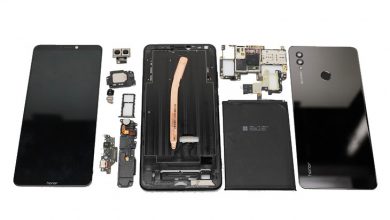As we all know, Huawei launched the Honor 10 last month. This phone has 6GB RAM and is powered by Huawei’s AI Kirin 970 processor. It also has excellent picture-taking effects. With its impressive appearance design and high specifications, the Honor 10 has received great popularity among the public. Today, we will take apart the phone to explore its internal design and workmanship.

First of all, remove the SIM card tray.

After taking out the SIM card tray, we found that it has a unibody metal design, which prevents it from easily breaking. Besides, this card slot doesn’t have a TF card slot, which means that the phone doesn’t support TF card expansion.

As no screw is found on the surface of the phone body, I decided to separate the back cover from the phone body to see its internal design. It is obvious that the back cover is fixed by double-sided tape. So, I heat up the device to make the tape less sticky.

Then, use a sucker to get the back cover slightly separated from the phone’s body.
Next, I need to insert a clip into the slot and gradually broaden the slot to separate the back cover from the phone body. During the process, avoid using excessive strength since it will break the glass or cause damage to the coating on the back.

After removing the back cover, we can see that most components inside have been covered by graphite stickers. The sticker is used to help heat dissipation from the motherboard. This design can largely solve the problem of heat accumulation caused by the poor heat dissipation performance of the glass back cover.

The phone’s back cover is well sealed, which can effectively prevent dust and water from entering inside.

Its metal middle framework has been thickened, especially at the four corners. Its metal middle frame has been thickened, especially at the four corners. These thickened parts mainly cushion the impact of the phone to protect the internal components from deformation.
Uncover the graphite sticker and the motherboard can be seen.

All the connectors on the motherboard are protected by a metal cover to avoid disconnection. The chip part is covered by shield covers.

The bridge circuit of the earphone and motherboard can be found on the top of the back of the cover plate. Other parts are used to fix the camera, connectors, and other components.
The LED flash is designed on the bridge circuit on the front of the cover plate. The phone comes with an LED flash.

We have successfully removed the camera module. The smartphone features 16MP and 24MP dual-rear cameras. The dual camera setup supports the AF function, but it fails to support the OIS function. It also comes with a 24MP front camera with an F/2.0 aperture.

Benefiting from Huawei’s developed chip with high integration and components with high density on the motherboard, the Honor 10 features a small motherboard. That’s the main reason why a 5.84-inch device can sport a battery with a capacity of 3400mAh. After all, the Vivo X21 has a 6.28-inch screen but only sports a 3200mAh battery.

There is only a shield cover on the motherboard, which can be removed. The part with the blue circle is the Hisilicon HI1102, which has Bluetooth, FMs, and other functions. The part with the red circle is the Hisilison HI6422 power management IC. The part with the yellow circle is the Hisilicon HI6421 processor power management chip.

Uncover the shield back on the back of the motherboard, and we can see a chip covered with yellow thermal silicone grease. From the SEC label on the surface of the chip, we can infer that it is Samsung’s 6GB K3UH6H6. The AI Kirin 70 chip is sealed under it. Samsung’s 128GB flash memory chip is near the processor.

The camera and earphones are closely connected. The light distance sensor is placed under the earphone. The foam is designed in the SIM card slot to improve its sealing.

Now, take out seven screws at the bottom.

The large loudspeaker module can bring loud and clear sound. We can also see the vibration module.

The Type-C port and earphone port have been integrated into the vice board. Two ports are covered by black rubber.

Then, we will remove the battery. This battery is fixed by double-sided tape, so I have to pry it up with a metal pry.

After taking out the battery, we can see information on this battery. Its limited charge voltage is 4.4V, and platform voltage is 3.82V. The battery cell is made by ATL. This battery has a capacity of 3400mAh, 12.99Wh.

After the teardown, we found that the phone has a good sealing design, which makes the phone more durable. The small-size motherboard with high integration provides more room for the phone’s 3400MAh battery. In general, the Honor 10 has good workmanship and reasonable internal design.
Teardown





